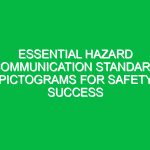Introduction
In today’s fast-paced work environment, safety is paramount. One of the crucial aspects of ensuring safety in the workplace is the effective communication of hazards. Hazard communication pictograms play a vital role in this endeavor. These visual symbols help workers quickly identify potential dangers associated with chemicals and other hazards. Understanding and utilizing these pictograms is essential for anyone involved in health, safety, and environment (HSE) practices. In this article, we will explore the intricacies of hazard communication pictograms, their significance in the HSE domain, and how they contribute to a safer working environment.
Understanding Hazard Communication Pictograms
Hazard communication pictograms are standardized symbols used to convey information about the hazards of chemicals. They are an integral part of the Globally Harmonized System of Classification and Labelling of Chemicals (GHS). This system was developed to ensure that workers around the world understand the risks associated with hazardous materials. The pictograms serve as visual cues that communicate information quickly and effectively, transcending language barriers.
The use of hazard communication pictograms is not just about compliance; it’s about creating a culture of safety. When workers can easily recognize the risks associated with the substances they handle, they can take appropriate precautions. This proactive approach to safety reduces workplace accidents and fosters a healthier work environment.
The Key Components of Hazard Communication Pictograms
To fully grasp the significance of hazard communication pictograms, it’s important to understand their components. Each pictogram consists of a unique symbol that signifies a particular hazard, framed within a diamond shape. The following are key components of these pictograms:
- Symbol: The symbol inside the diamond shape is the most crucial element, representing a specific hazard.
- Color: The color of the pictogram typically indicates the nature of the hazard. For instance, red is often used for fire hazards, while yellow may indicate caution.
- Border: The diamond shape with a black border helps to distinguish the pictogram from other types of signage, ensuring it captures attention.
Categories of Hazard Communication Pictograms
The GHS has established a set of pictograms that address various types of hazards. Here are some of the most common categories:
1. Health Hazards
These pictograms indicate dangers that can cause serious health issues, such as carcinogenicity, respiratory sensitization, or reproductive toxicity. A common example is the figure of a person with a star, symbolizing health risks.
2. Physical Hazards
Pictograms in this category represent risks related to the physical properties of a substance, such as flammability or explosiveness. For instance, a flame pictogram indicates flammable materials, alerting workers to the potential for fire.
3. Environmental Hazards
These symbols signal hazards that may pose a risk to the environment. An example is the pictogram depicting a dead fish and a tree, which warns of potential aquatic and terrestrial environmental dangers.
4. Corrosive Materials
The pictogram representing corrosive materials typically shows a substance that can cause severe skin burns or eye damage. This warning is essential in laboratories and industries that handle such chemicals.
The Importance of Implementing Hazard Communication Pictograms
Implementing hazard communication pictograms is a critical step for organizations aiming to enhance workplace safety. Here are several reasons why these pictograms are essential:
1. Quick Recognition of Hazards
Pictograms provide immediate recognition of hazards, allowing workers to react swiftly. For example, seeing a flame pictogram can prompt a worker to take extra precautions when handling flammable substances.
2. Compliance with Regulations
Many countries have adopted the GHS, making it a regulatory requirement in various industries. Compliance not only avoids potential legal issues but also promotes a culture of safety.
3. Enhanced Safety Training
When training employees, using pictograms can significantly enhance understanding. Visual aids are often more effective than text alone, especially for those who may struggle with language barriers.
4. Reduction of Workplace Accidents
With clear communication of hazards, the likelihood of accidents decreases. A study conducted by the National Institute for Occupational Safety and Health (NIOSH) found that workplaces using hazard communication pictograms reported fewer incidents related to chemical exposure.
Best Practices for Utilizing Hazard Communication Pictograms
To maximize the effectiveness of hazard communication pictograms, organizations should adopt best practices:
1. Regular Training
Conduct regular training sessions to ensure that all employees understand the meanings of the pictograms. This training should include real-life scenarios to reinforce learning.
2. Clear Display
Pictograms should be prominently displayed in areas where hazardous materials are used or stored. This ensures visibility and reinforces awareness.
3. Comprehensive Labeling
In addition to pictograms, labels should include supplementary information such as hazard statements, precautionary measures, and first-aid instructions. This holistic approach enhances understanding.
4. Consistent Updates
As new hazards emerge or regulations change, organizations should update their pictograms and training materials accordingly. Staying current is key to maintaining a safe work environment.
Potential Hazards and Safety Considerations
While hazard communication pictograms are essential for promoting safety, it is also crucial to understand the potential hazards associated with the chemicals they represent. For instance, improper handling of corrosive substances can lead to severe injuries. In a hypothetical scenario, if an employee fails to recognize the corrosive pictogram on a chemical container, they may inadvertently expose themselves to dangerous materials.
Moreover, creating a culture of safety goes beyond just recognizing pictograms. It involves promoting open communication about safety concerns and reporting near-misses or accidents. This proactive approach helps identify risks before they lead to incidents.
Regulations and Standards Governing Hazard Communication Pictograms
Several regulations govern the use of hazard communication pictograms, particularly in the United States where OSHA (Occupational Safety and Health Administration) has established standards. The OSHA Hazard Communication Standard (HCS) aligns with the GHS, requiring the use of pictograms on labels for hazardous chemicals.
In addition, various countries have their own regulations, which may differ slightly. For instance, the European Union has the Classification, Labelling, and Packaging (CLP) Regulation, which also incorporates pictograms into their chemical safety protocols.
These regulations not only ensure compliance but also serve as a framework for organizations to improve their safety practices. Compliance with these standards can also enhance a company’s reputation, as it demonstrates a commitment to employee safety.
Conclusion
In conclusion, hazard communication pictograms are a vital tool in promoting workplace safety. By providing clear visual representations of potential hazards, these pictograms enable workers to make informed decisions and take appropriate actions to protect themselves and their colleagues. The importance of implementing these pictograms cannot be overstated, as they not only ensure compliance with regulations but also contribute to a culture of safety.
As organizations continue to evolve and adapt to new challenges, the emphasis on effective hazard communication will remain crucial. By prioritizing the understanding and use of hazard communication pictograms, workplaces can significantly reduce the risks associated with hazardous materials, ultimately fostering a safer and healthier working environment. It is imperative for all stakeholders in the HSE domain to recognize the importance of these pictograms and take proactive steps towards promoting safety in the workplace.


